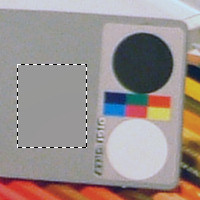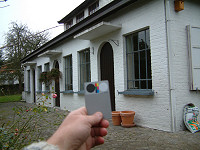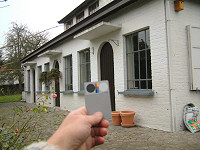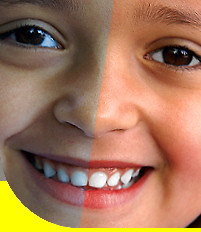| |
Choose the moment to photograph the Digi Grey.
You are not forced to photograph the Digi Grey while you photograph your subject. Indeed, if you photograph people, you will lose spontaneity if you ask them to hold the Digi Grey while you make the photo. It is better, in that case, to take the reference photo with the Digi Grey just after the session of shots.
If you are doing outdoor shots you can photograph the Digi Grey before beginning the shoot.
|
|
| |
Increase the precision of the Dropper tool.
In your graphic software, you measure the grey of the Digi Grey on the reference photo by using the "Dropper" tool. You will undoubtedly have noticed that the displayed RGB values vary according to the place where you place the Dropper on the grey and can lead to an erroneous correction of the white balance.
If you enlarge (zoom) strongly the area of grey on the screen, you will observe that it is not uniform. It is constituted by pixels of different colors. It can be also caused by the digital noise. If the Dropper of your software measures one pixel at once, the displayed values will be different for every pixel. A software like Paint Shop Pro allows the number of pixels sampled by the Dropper to be adjusted (until 11x11 pixels). In that case, the displayed measure is the average of the pixels and is thus more precise. But it can sometimes be insufficient. The trick consists in blurring the reference grey (gaussian blur of 30 or more) before making the measure with the Dropper. This action results in the mixing of the pixel colours and creates a more precise uniform grey to be measured. |
 |
| |
Manipulate the Digi Grey carefully.
Do not hold Digi Grey with dirty fingers. The matt surface, due to its consistency,will stain easily. If you manipulate the Digi grey with dirty fingers, have a cloth to cover the fingers. If the grey of the Digi Grey is no more uniform then the corrections result will not be accurate. This matt surface is to protect against scratches, shocks and frictions. See also "My Digi Grey is dirty. How should I clean it?". |
|
| |
Improve the performances.
In every software or plug-in the white balance setting results from an algorithm (mathematical formula) designed by the designer of the software. This algorithm is sometimes the object of a patent. It explains the differences of results obtained for the same photo by various softwares.
In principle, the measure of the grey with the grey Dropper should be sufficient. But with certain software, the measure of the areas of white and black in addition to the grey is necessary to obtain a better result. If you browsed the pages of this site dedicated to the use of the Digi Grey with various softwares, you will have noticed that the order in which it is necessary to use the droppers of grey, white and black varies from a software to the other one.
If you do not obtain a satisfying result with a particular photo then experiment. For example, for the photo opposite, a more flattering correction was obtained by using the grey dropper to measure the WHITE area of the the Digi Grey. Indeed, on the photo of origin, this area is very grey and the algorithm of the software, for a reason which we ignore, made a better work with this area.
|

 |
| |
Orientate the Digi Grey.
Although the matt surface of the Digi Grey was designed to minimize the reflections, it is not possible to completely remove any reflection of the angular type. To avoid any problem of specular reflection, the ideal position is an incidental light in 45 degrees on the Digi Grey and this one directed in 90 degrees with regard to the camera. For example under the sun at noon, you direct the Digi Grey to the camera. But if you use as a source of lighting the camera flash (indoor photos), then the Digi Grey does not face the camera. If it faces the camera, it may be too white and correction will not be possible. Imagine the Digi Grey as a mirror. Orientate the Digi Grey so that the camera never "sees" the light source in the "mirror".
Examples of photos improved thanks to the Digi Grey |
|
|
 |













